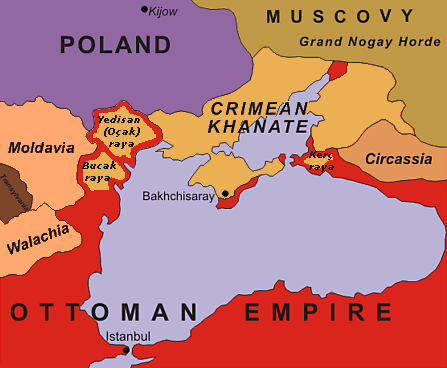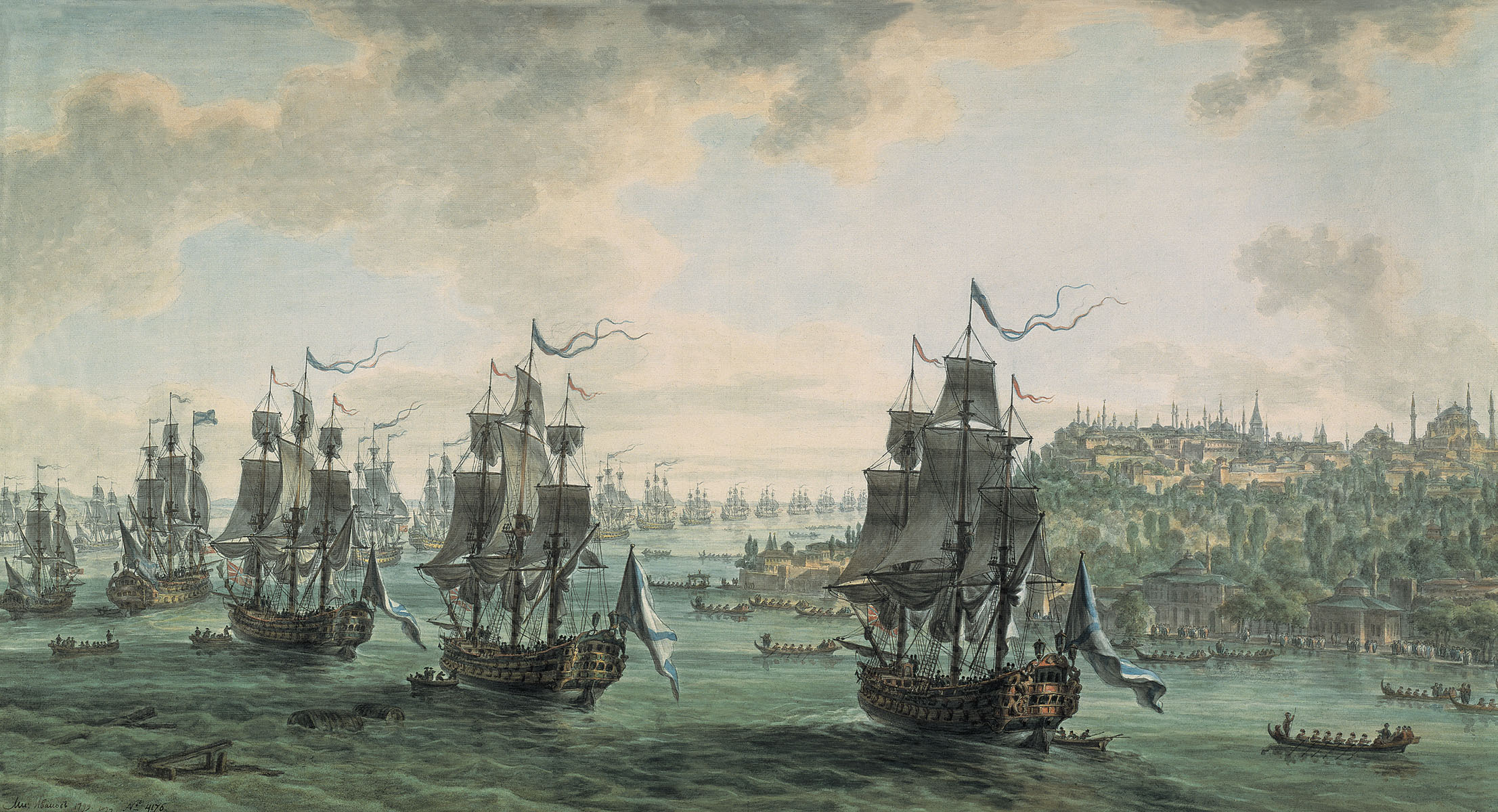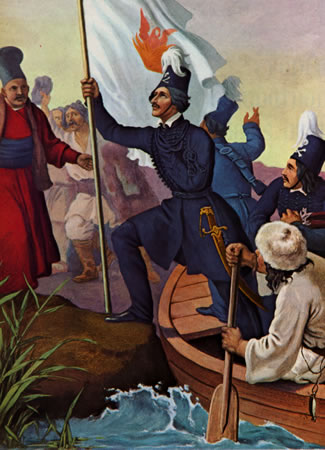|
Siege Of Bender (1770)
The siege of Bender was a military conflict of the Russo-Turkish War of 1768–1774. The 2nd Russian Army, led by Count Petr Ivanovich Panin, took the Turkish fortress of Bender, located in modern-day Moldova. Siege The siege of the Tighina Fortress, which was a powerful stronghold of the Ottoman Empire, commenced on 15 July 1770 and lasted two months. The Bender garrison, numbering over 12,000 people (according to other sources, up to 30,000 people), including select Janissaries, confronted a nearly 33,000-strong Russian army (18,567 infantry, 10,673 cavalry, 3,574 artillery and engineering troops). The commander of the 2nd Army, Count Petr Ivanovich Panin, initially hoped to force the fortress to capitulate by attrition and cannon fire. played an important role in managing the siege works. On the eve of the assault planned for 15 September, the shelling intensified, and a fire broke out in the city due to the cannonade. On 15 September, a powerful mine (400 pounds of gunpo ... [...More Info...] [...Related Items...] OR: [Wikipedia] [Google] [Baidu] |
Russo-Turkish War (1768–1774)
The Russo-Turkish wars ( ), or the Russo-Ottoman wars (), began in 1568 and continued intermittently until 1918. They consisted of twelve conflicts in total, making them one of the longest series of wars in the history of Europe. All but four of these wars ended in losses for the Ottoman Empire, which was undergoing a period of stagnation and decline. Conversely, they showcased the ascendancy of the Russian Empire as a significant European power after Peter the Great oversaw extensive modernization efforts in the early 18th century. Ultimately, however, the end of the Russo-Turkish wars came about with the dissolution of the two belligerents' respective states as a consequence of World War I: the Russian Empire collapsed in 1917 and was ultimately succeeded by the Union of Soviet Socialist Republics in 1922; while the Ottoman Empire was partitioned between 1918 and 1922 and succeeded by the Republic of Turkey in 1923. History Initial and intermediate phases (1568–1739) ... [...More Info...] [...Related Items...] OR: [Wikipedia] [Google] [Baidu] |
Bender, Moldova
Bender (, ) or Bendery (, ; ), also known as Tighina ( mo-Cyrl, Тигина, links=no), is a city within the internationally recognized borders of Moldova under ''de facto'' control of the unrecognized Transnistria, Pridnestrovian Moldavian Republic (Transnistria) (PMR) since 1992. It is located on the western bank of the river Dniester in the historical region of Bessarabia. Together with its suburb Proteagailovca, the city forms a municipality, which is separate from Administrative-Territorial Units of the Left Bank of the Dniester, Transnistria (as an administrative unit of Moldova) according to Moldovan law. Bender is located in the buffer zone established at the end of the 1992 War of Transnistria. While the Joint Control Commission has overriding powers in the city, Transnistria has ''de facto'' administrative control. The Tighina Fortress, fortress of Tighina was one of the important historic fortresses of the Principality of Moldova until 1812. Name First mentioned in ... [...More Info...] [...Related Items...] OR: [Wikipedia] [Google] [Baidu] |
Ottoman Empire
The Ottoman Empire (), also called the Turkish Empire, was an empire, imperial realm that controlled much of Southeast Europe, West Asia, and North Africa from the 14th to early 20th centuries; it also controlled parts of southeastern Central Europe, between the early 16th and early 18th centuries. The empire emerged from a Anatolian beyliks, ''beylik'', or principality, founded in northwestern Anatolia in by the Turkoman (ethnonym), Turkoman tribal leader Osman I. His successors Ottoman wars in Europe, conquered much of Anatolia and expanded into the Balkans by the mid-14th century, transforming their petty kingdom into a transcontinental empire. The Ottomans ended the Byzantine Empire with the Fall of Constantinople, conquest of Constantinople in 1453 by Mehmed II. With its capital at History of Istanbul#Ottoman Empire, Constantinople (modern-day Istanbul) and control over a significant portion of the Mediterranean Basin, the Ottoman Empire was at the centre of interacti ... [...More Info...] [...Related Items...] OR: [Wikipedia] [Google] [Baidu] |
Mikhail Matveevich Ivanov
Mikhail Matveevich Ivanov (; 1748, St. Petersburg – 28 ( 16) August 1823, St. Petersburg) was a Russian painter, watercolorist, and Academician. Biography His father was a soldier in the Semyonovsky Regiment. In 1762, he and his brother, were admitted to the Imperial Academy of Arts. He initially took practical courses on painting with varnishes then, in 1764, became a student of , who instructed him in painting birds, animals and flowers. He was awarded a silver medal in 1769, followed by a gold medal in 1770, for his landscape with staffage, depicting an olive tree with military paraphernalia, soldiers and shepherds. This also earned him a study trip to Western Europe. In Paris he studied with Jean-Baptiste Le Prince, with whom he copied landscapes by the Old Masters. He was especially drawn to Dutch and Flemish artists. In 1773, he and Arkhip went to Rome, where he painted landscapes en plein aire and copied more of the Old Masters, many of which he sent back to the A ... [...More Info...] [...Related Items...] OR: [Wikipedia] [Google] [Baidu] |
1783 Ottoman Flag
Events January–March * January 20 – At Versailles, Great Britain signs preliminary peace treaties with the Kingdom of France and the Kingdom of Spain. * January 23 – The Confederation Congress ratifies two October 8, 1782, treaties signed by the United States with the United Netherlands. * February 3 – American Revolutionary War: Great Britain acknowledges the independence of the United States of America. At this time, the Spanish government does not grant diplomatic recognition. * February 4 – American Revolutionary War: Great Britain formally declares that it will cease hostilities with the United States. * February 5 – 1783 Calabrian earthquakes: The first of a sequence of five earthquakes strikes Calabria, Italy (February 5–7, March 1 & 28), leaving 50,000 dead. * February 7 – The Great Siege of Gibraltar is abandoned. * February 26 – The United States Continental Army's Corps of Engineers is disbanded. * March 5 ... [...More Info...] [...Related Items...] OR: [Wikipedia] [Google] [Baidu] |
Petr Ivanovich Panin
General Count Pyotr (Petr) Ivanovich Panin () (1721 – April 26, 1789), younger brother of Nikita Ivanovich Panin, fought with distinction in the Seven Years' War and in the Russo-Turkish War, 1768-1774, Russo-Turkish War of 1768–1774, Siege of Bender (1770), capturing Bender on September 26, 1770. In 1773–1775, he participated in suppressing Pugachev's Rebellion. He died in Moscow, as the senior General of the Imperial Russian Army, Russian Army. He is the father of Nikita Petrovich Panin. References ''Original text adapted from Meyers Konversations-Lexikon, 4th edition''. 1721 births 1789 deaths Nobility from the Russian Empire Imperial Russian Army generals Recipients of the Order of St. George of the First Degree Pugachev's Rebellion Russian military personnel of the Seven Years' War People of the Russo-Turkish War (1768–1774) {{Russia-noble-stub ... [...More Info...] [...Related Items...] OR: [Wikipedia] [Google] [Baidu] |
Moldova
Moldova, officially the Republic of Moldova, is a Landlocked country, landlocked country in Eastern Europe, with an area of and population of 2.42 million. Moldova is bordered by Romania to the west and Ukraine to the north, east, and south. The List of states with limited recognition, unrecognised breakaway state of Transnistria lies across the Dniester river on the country's eastern border with Ukraine. Moldova is a Unitary state, unitary Parliamentary system, parliamentary Representative democracy, representative democratic republic with its capital in Chișinău, the country's largest city and main cultural and commercial centre. Most of Moldovan territory was a part of the Principality of Moldavia from the 14th century until 1812, when it was Treaty of Bucharest (1812), ceded to the Russian Empire by the Ottoman Empire (to which Moldavia was a Vassal and tributary states of the Ottoman Empire, vassal state) and became known as Bessarabia. In 1856, southern Bessarabia was ... [...More Info...] [...Related Items...] OR: [Wikipedia] [Google] [Baidu] |
Tighina Fortress
The Tighina Fortress (; renamed by the Turks as Bender) is a 15th-century fortress on the right bank of the Dniester River in Bender (also known as Tighina), Moldova, built from earth and wood during the reign of Prince Stephen the Great. In 1538 it was conquered by the Turkish sultan Suleiman the Magnificent, who ordered it to be rebuilt in stone and enlarged. History The earliest mention of Tighina, as a settlement and customs post, is found in the commercial privilege granted on October 6, 1408, by the Prince of Moldavia Alexander the Good to the merchants of Lviv. Later, throughout the 15th and 16th centuries, the name of Tighina is frequently recorded in medieval documents. In the Moldavian documents that mention the locality, in Tighina, along with the royal customs and the crossing, a ''guard'' is mentioned. In the only document from the Prince Stephen the Great (1457-1504) in which Tighina appears, the ''guard'' is also mentioned. As for the ''fortress'' of Tighina, 19 ... [...More Info...] [...Related Items...] OR: [Wikipedia] [Google] [Baidu] |
Dniester
The Dniester ( ) is a transboundary river in Eastern Europe. It runs first through Ukraine and then through Moldova (from which it more or less separates the breakaway territory of Transnistria), finally discharging into the Black Sea on Ukrainian territory again. Names The name ''Dniester'' derives from Sarmatian ''dānu nazdya'' "the close river". (The Dnieper, also of Sarmatian origin, derives from the opposite meaning, "the river on the far side".) Alternatively, according to Vasily Abaev ''Dniester'' would be a blend of Scythian ''dānu'' "river" and Thracian ''Ister'', the previous name of the river, literally Dān-Ister (River Ister). The Ancient Greek name of Dniester, ''Tyras'' (Τύρας), is from Scythian ''tūra'', meaning "rapid". The names of the Don and Danube are also from the same Iranian word ''*dānu'' "river". Classical authors have also referred to it as ''Danaster.'' These early forms, without -''i''- but with -''a''-, contradict Abaev's hypoth ... [...More Info...] [...Related Items...] OR: [Wikipedia] [Google] [Baidu] |
Prut
The Prut (also spelled in English as Pruth; , ) is a river in Eastern Europe. It is a left tributary of the Danube, and is long. Part of its course forms Romania's border with Moldova and Ukraine. Characteristics The Prut originates on the eastern slope of Mount Hoverla, in the Carpathian Mountains in Ukraine ( Ivano-Frankivsk Oblast). At first, the river flows to the north. Near Yaremche it turns to the northeast, and near Kolomyia to the south-east. Having reached the border between Moldova and Romania, it turns even more to the south-east, and then to the south. It eventually joins the Danube near Giurgiulești, east of Galați and west of Reni. Between 1918 and 1939, the river was partly in Poland and partly in Greater Romania (Romanian: ''România Mare''). Prior to World War I, it served as a border between Romania and the Russian Empire. After World War II, the river once again denoted a border, this time between Romania and the Soviet Union. Nowadays, for a length of ... [...More Info...] [...Related Items...] OR: [Wikipedia] [Google] [Baidu] |
Order Of St
Order, ORDER or Orders may refer to: * A socio-political or established or existing order, e.g. World order, Ancien Regime, Pax Britannica * Categorization, the process in which ideas and objects are recognized, differentiated, and understood * Heterarchy, a system of organization wherein the elements have the potential to be ranked a number of different ways * Hierarchy, an arrangement of items that are represented as being "above", "below", or "at the same level as" one another * an action or inaction that must be obeyed, mandated by someone in authority People * Orders (surname) Arts, entertainment, and media * ''Order'' (film), a 2005 Russian film * ''Order'' (album), a 2009 album by Maroon * "Order", a 2016 song from '' Brand New Maid'' by Band-Maid * ''Orders'' (1974 film), a film by Michel Brault * "Orders" (''Star Wars: The Clone Wars'') Business * Blanket order, a purchase order to allow multiple delivery dates over a period of time * Money order or postal orde ... [...More Info...] [...Related Items...] OR: [Wikipedia] [Google] [Baidu] |
1770 In The Ottoman Empire
Year 177 ( CLXXVII) was a common year starting on Tuesday of the Julian calendar. At the time, it was known as the Year of the Consulship of Commodus and Plautius (or, less frequently, year 930 ''Ab urbe condita''). The denomination 177 for this year has been used since the early medieval period, when the Anno Domini calendar era became the prevalent method in Europe for naming years. Events By place Roman Empire * Lucius Aurelius Commodus Caesar (age 15) and Marcus Peducaeus Plautius Quintillus become Roman Consuls. * Commodus is given the title ''Augustus'', and is made co-emperor, with the same status as his father, Marcus Aurelius. * A systematic persecution of Christians begins in Rome; the followers take refuge in the catacombs. * The churches in southern Gaul are destroyed after a crowd accuses the local Christians of practicing cannibalism. * Forty-eight Christians are martyred in Lyon (Saint Blandina and Pothinus, bishop of Lyon, are among them). [...More Info...] [...Related Items...] OR: [Wikipedia] [Google] [Baidu] |







